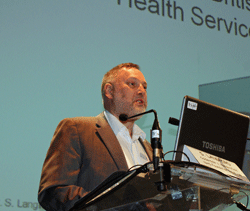Tests de stérilité
3 octobre 2010
S. Langford Huddersfield Royal Infirmery, Huddersfield, UK
The British National Health Service (NHS) has always manufactured medicines since it was created in 1948. There is still a legacy from these times particularly in the wide variety of non-sterile traditional formulations still prepared, particularly for dermatological use.
In the intervening years medicines manufacturing has considerably developed with the advent of aseptic medicines preparation and the increasing role of the private commercial sector. It must be emphasised that the vast majority of these medicines are “unlicensed” and have not undergone the intensive product development of licensed medicines.
In 2003 the British Government invested €53million in modernising the Hospital Pharmacy Manufacturing Unit (PMU) network. This money was used to rationalise the number of small hospital based operations into a network of large lead units (13) and support units (11).
These units cover a very diverse range of activities, which include some or all of the following ;
- Sterile manufacturing of terminally sterilized products
- Aseptic manufacturing of pre-filled syringes, eye-drops and other items.
- Non-sterile manufacturing
- Aseptic compounding i.e. TPN, chemotherapy, CIVAS and diagnostic radio-pharmaceuticals
- Extemporaneous dispensing services.
In addition there are about 120 aseptic compounding units in British hospitals.
The current organisation is led by the National Advisory Board for NHS medicines preparation and manufacturing. This Board seeks to co-ordinate the various NHS groups involved, oversee the large manufacturing units. It also has an important role in rationalising the number of unlicensed medicines and encouraging the development of licensed medicines where the demand will support this ; which is likely to involve working with the commercial sector.
Unlicensed medicines in the UK are also provided by the private commercial companies, which have seen significant growth over the last 10 years, particularly in regard to aseptically prepared products (chemotherapy, TPN and CIVAS) and extemporaneous dispensing services to community pharmacies.
The regulation of unlicensed medicines is currently being reviewed by the Medicines and Healthcare products Regulatory Agency (MHRA). There will be greater control over what may be manufactured, enhanced requirements for stability information, pharmaco- vigilance. Additionally the current law only allows advertising of the unlicensed medicines manufacturing service, not the products ; it is likely that this will be relaxed in the light off price abuses within the supply chain.
Sterility testing of sterile products manufactured in British Hospital
S. Langford – Calderdale & Huddersfield NHS Foundation Trust, UK
Where the sterility test is used, it is in accordance with the British/European monographs. The main use is in the testing of batch produced sterile products, for intravenous administration, manufactured by the large NHS Pharmacy Manufacturing Units (PMU).
However there are a number of issues ;
- Sterility testing involves a small sample of the batch and therefore lacks sensitivity.
- There is a minimum of two weeks waiting for results, which significantly affects the usable shelf life of short shelf life aseptically prepared products.
- Good aseptic facilities and scrupulous aseptic techniques are essential.
- Even in large NHS units batch sizes are small by industrial standards ; hence any sterility test failure cannot be mitigated by statistical treatment and therefore represents a catastrophic failure of the system.
- NHS units have large portfolios of products, often 100 sterile product lines or more, and validating sterility testing across this range of products is demanding.
In practice sterility testing is used as follows ;
- Despite the shortcomings the Regulator (MHRA) likes it and it is used to support batch release in large NHS PMUs.
- It is applied to products for intravenous administration, irrigation fluids and eye-drops.
- Hospital based aseptic units may use the test retrospectively to build up confidence in their systems e.g. submitting unused TPN bags for testing.
- Some categories of products are not sterility tested due to handling issues e.g. chemotherapy injections and radio-pharmaceuticals.
- However unofficial “surrogate” testing e.g. adding broth to decayed radio-pharmaceuticals is used.
In view of the above additional strategies to provide assurance of sterility are essential ; these include ;
- Bio-burden testing of bulk solutions.
- Broth process validation runs – at least annually.
- Operator aseptic technique testing – often 3 monthly.
- Transfer validation in aseptic units.
- End of run broth fills.
- Filter integrity testing.